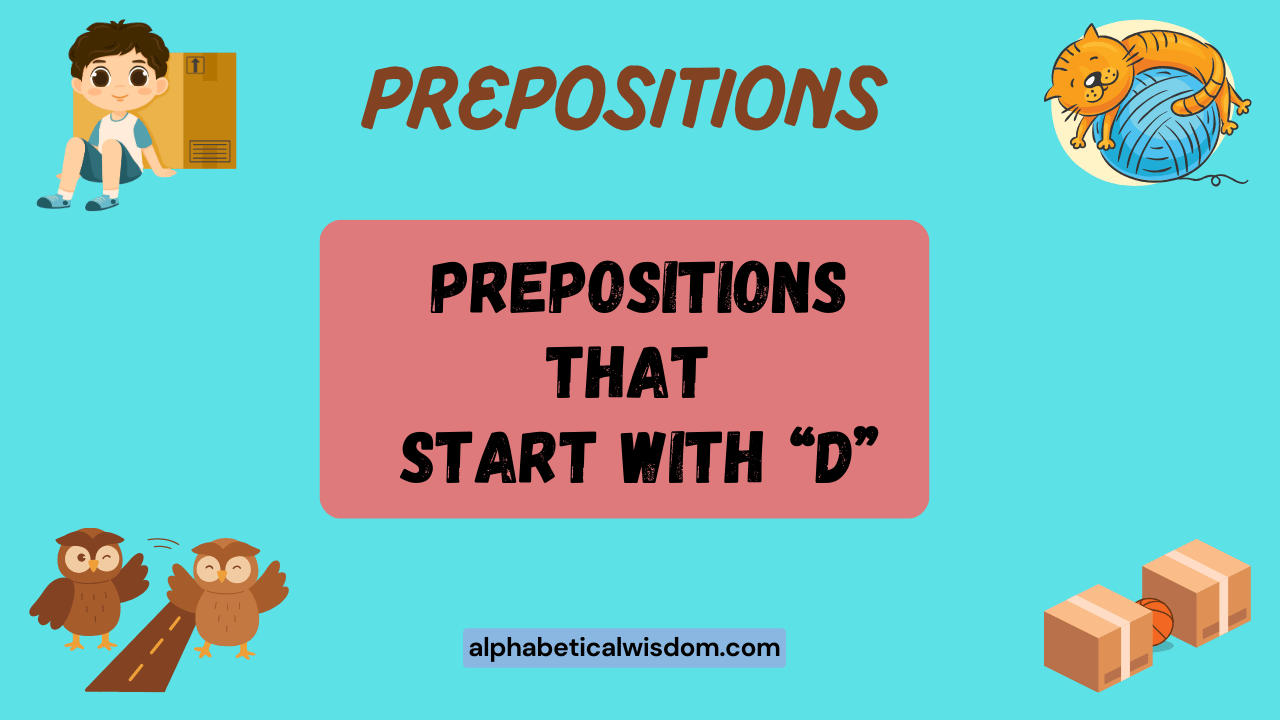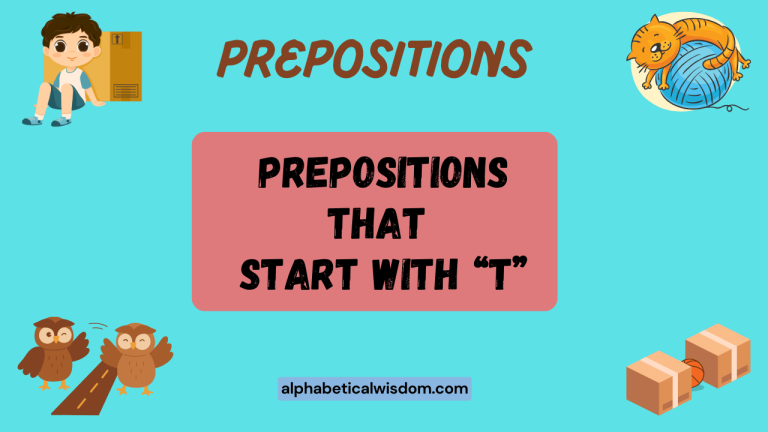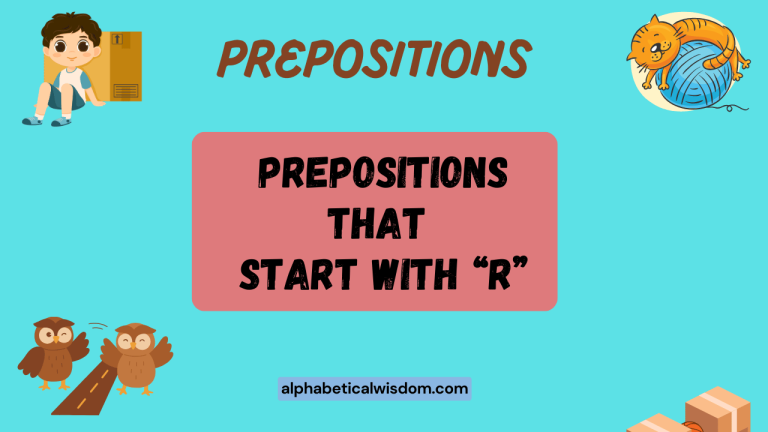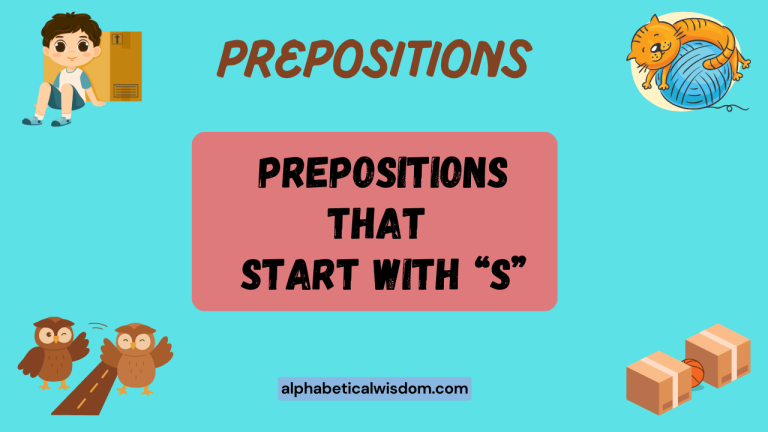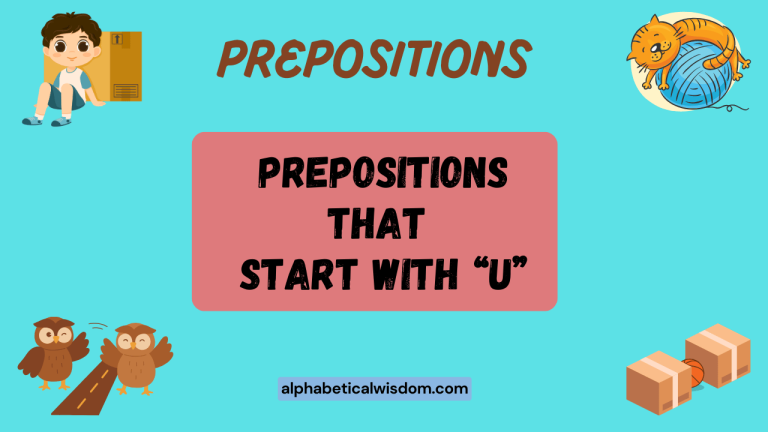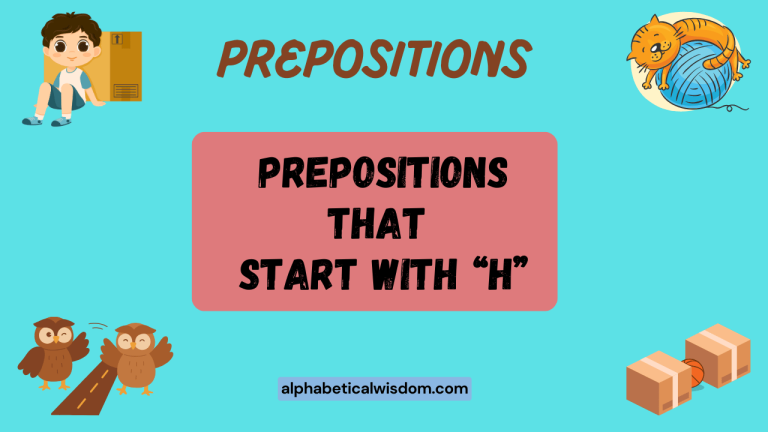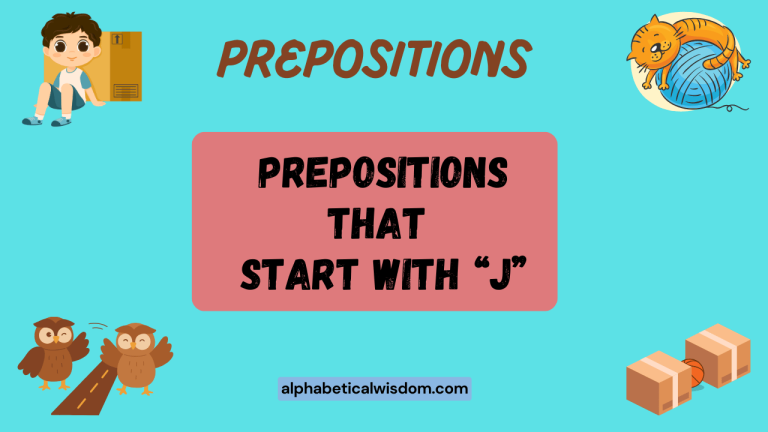Prepositions Starting with D: A Comprehensive English Guide
Mastering prepositions is crucial for achieving fluency and accuracy in English. Prepositions act as essential connectors, linking nouns, pronouns, and phrases to other parts of a sentence.
This article focuses specifically on prepositions that begin with the letter “D,” providing a detailed exploration of their meanings, usage, and common pitfalls. Understanding these “D” prepositions will enhance your ability to construct clear, precise, and grammatically correct sentences.
This guide is beneficial for English language learners of all levels, from beginners seeking a foundational understanding to advanced speakers aiming to refine their grasp of nuanced grammar rules.
Table of Contents
- Introduction
- Definition of Prepositions
- Structural Breakdown
- Types and Categories of Prepositions Starting with D
- Examples of Prepositions Starting with D
- Usage Rules
- Common Mistakes
- Practice Exercises
- Advanced Topics
- FAQ
- Conclusion
Definition of Prepositions
A preposition is a word that connects a noun, pronoun, or noun phrase to other words in a sentence. Prepositions typically indicate location, direction, time, or the relationship between objects or ideas.
They are essential for providing context and clarity in communication. Without prepositions, sentences would lack crucial details regarding spatial, temporal, and logical connections.
Prepositions are classified as a type of function word, meaning they primarily serve a grammatical purpose rather than carrying significant lexical content on their own. Their function is to establish relationships between different elements within a sentence. These relationships can express a wide range of meanings, including spatial position (on, in, under), temporal relationships (before, after, during), and abstract connections (of, for, by).
The context in which a preposition is used heavily influences its specific meaning. For example, the preposition “on” can indicate physical placement (the book is on the table), a specific date (on Monday), or a state of being (on vacation). Understanding these contextual nuances is key to using prepositions correctly and effectively.
Structural Breakdown
Prepositions are typically followed by a noun or pronoun, which together form a prepositional phrase. The prepositional phrase functions as an adjective or adverb, modifying other words in the sentence. The noun or pronoun that follows the preposition is called the object of the preposition.
The basic structure of a prepositional phrase is: Preposition + Object of the Preposition. For example, in the phrase “during the meeting,” “during” is the preposition, and “the meeting” is the object of the preposition. The entire phrase functions adverbially, modifying the verb or clause it’s attached to.
Prepositional phrases can be simple or complex. A simple prepositional phrase consists of just the preposition and its object, while a complex prepositional phrase may include modifiers or other phrases within the object. For example, “in the early morning” is a more complex prepositional phrase than “in the morning.” The complexity of the phrase does not change its fundamental function as a modifier.
Types and Categories of Prepositions Starting with D
This section focuses on specific prepositions that begin with the letter “D,” exploring their unique meanings and appropriate contexts for use. We will cover “down,” “during,” “despite,” “due to,” and “down to” in detail.
Down
“Down” is a preposition that typically indicates movement from a higher to a lower point or position. It can also describe a progression or decrease.
“Down” often implies a direction or path that is descending or leading to a lower level.
Examples:
- The ball rolled down the hill.
- She walked down the stairs.
- The price of gas went down.
During
“During” is a preposition that specifies when something happens within a particular period or event. It indicates that an action or state occurs throughout the course of something else.
“During” is used to define the temporal context of an action.
Examples:
- I fell asleep during the movie.
- He worked hard during the summer.
- The phone rang during dinner.
Despite
“Despite” is a preposition that introduces a contrast or contradiction. It indicates that something occurs even though there is a factor that might have prevented it.
“Despite” is similar to “in spite of” and sets up a situation where something unexpected happens.
Examples:
- Despite the rain, we went for a walk.
- Despite his efforts, he failed the exam.
- Despite the cost, they bought the car.
Due to
“Due to” is a prepositional phrase that explains the cause or reason for something. It indicates that something is a result of a specific factor or event.
“Due to” is often used to provide an explanation or justification.
Examples:
- The game was canceled due to the weather.
- His success was due to hard work.
- The delay was due to unforeseen circumstances.
Down to
“Down to” is a prepositional phrase that can indicate responsibility, a remaining task, or a simplification of something. It often implies a reduction to the essential elements or the final stage of a process.
Examples:
- It’s down to you to finish the project.
- We are down to the last few ingredients.
- The problem is down to a simple misunderstanding.
Examples of Prepositions Starting with D
This section provides extensive examples of prepositions starting with “D” used in various contexts. These examples are categorized to illustrate the different meanings and applications of each preposition.
Examples of “Down”
The following table illustrates various uses of the preposition “down” indicating movement, direction, or descent.
| Sentence | Explanation |
|---|---|
| The river flows down the mountain. | Indicates movement from a higher to a lower point. |
| She walked down the street. | Specifies the direction of movement. |
| The temperature went down last night. | Shows a decrease in value. |
| He looked down at his shoes. | Indicates the direction of his gaze. |
| The cat jumped down from the fence. | Indicates a downward movement. |
| I ran down the stairs quickly. | Describes rapid downward motion. |
| The sun is going down. | Indicates the setting of the sun. |
| The plane is coming down for a landing. | Describes the descent of an aircraft. |
| She poured water down the drain. | Specifies the direction of pouring. |
| The climber rappelled down the cliff. | Describes a controlled descent. |
| The balloon floated down gently. | Indicates a slow downward movement. |
| He bent down to pick up the coin. | Describes the action of bending downward. |
| The curtain fell down from the rod. | Indicates a dropping motion. |
| The path leads down to the beach. | Specifies the direction of the path. |
| The company’s profits are down this quarter. | Shows a decrease in financial performance. |
| He wrote down the phone number. | Describes the action of recording information. |
| The singer’s voice faded down at the end of the song. | Indicates a decrease in volume. |
| The team is down by ten points. | Shows a deficit in score. |
| The project was scaled down due to budget cuts. | Indicates a reduction in scope. |
| She calmed down after the stressful event. | Describes a decrease in emotional intensity. |
| The ladder extends down to the basement. | Specifies the direction and extent of the ladder. |
| The rain poured down in sheets. | Describes heavy rainfall. |
| He looked down on those less fortunate. | Indicates a feeling of superiority. |
Examples of “During”
The following table provides examples of the preposition “during” showing temporal relationships and defining when events occur.
| Sentence | Explanation |
|---|---|
| I studied during the afternoon. | Specifies the time when studying occurred. |
| She slept during the flight. | Indicates when she was sleeping. |
| He worked during the summer. | Defines the period when he worked. |
| The store is closed during the holidays. | Indicates the time when the store is closed. |
| We met during the conference. | Specifies the event when they met. |
| The power went out during the storm. | Indicates when the power outage occurred. |
| He felt sick during the performance. | Specifies when he felt unwell. |
| She learned a lot during her internship. | Indicates the period of learning. |
| The children behaved well during the party. | Specifies when they were well-behaved. |
| The flowers bloom during the spring. | Indicates the season when the flowers bloom. |
| The noise was constant during the construction. | Specifies the period of constant noise. |
| He took notes during the lecture. | Indicates when he was taking notes. |
| The traffic is heavy during rush hour. | Specifies the time of heavy traffic. |
| She practiced during her free time. | Indicates when she practiced. |
| The museum is open during the week. | Specifies the days when the museum is open. |
| He meditates during the morning. | Indicates the time of meditation. |
| The birds sing during the dawn. | Specifies when the birds sing. |
| She volunteered during the event. | Indicates when she volunteered. |
| The project was completed during the year. | Specifies the time of completion. |
| He relaxed during the vacation. | Indicates when he relaxed. |
| The company grew during the economic boom. | Specifies the period of growth. |
| She felt nervous during the presentation. | Indicates when she felt nervous. |
| The city is vibrant during the festival. | Specifies when the city is vibrant. |
Examples of “Despite”
The following table showcases the use of “despite” to introduce contrasting elements within sentences.
| Sentence | Explanation |
|---|---|
| Despite the cold, they went swimming. | Contrasts the cold weather with the action of swimming. |
| Despite his illness, he attended the meeting. | Contrasts his illness with his attendance. |
| Despite the difficulty, she finished the race. | Contrasts the difficulty with her completion. |
| Despite the warning, he ignored the advice. | Contrasts the warning with his action. |
| Despite the cost, they bought the house. | Contrasts the high price with their purchase. |
| Despite the rain, the parade continued. | Contrasts the rain with the continuation of the parade. |
| Despite the noise, she concentrated on her work. | Contrasts the noise with her concentration. |
| Despite the distance, they remained friends. | Contrasts the distance with their friendship. |
| Despite the criticism, he continued his research. | Contrasts the criticism with his continuation. |
| Despite the setbacks, she achieved her goal. | Contrasts the setbacks with her achievement. |
| Despite the challenges, they succeeded. | Contrasts the challenges with their success. |
| Despite the risks, he took the chance. | Contrasts the risks with his taking the chance. |
| Despite the odds, they won the game. | Contrasts the unfavorable odds with their victory. |
| Despite the problems, they enjoyed the trip. | Contrasts the problems with their enjoyment. |
| Despite the confusion, she understood the instructions. | Contrasts the confusion with her understanding. |
| Despite the limitations, they made progress. | Contrasts the limitations with their progress. |
| Despite the lack of resources, they completed the project. | Contrasts the lack of resources with their completion. |
| Despite the complexity, he understood the concept. | Contrasts the complexity with his understanding. |
| Despite the opposition, they implemented the plan. | Contrasts the opposition with their implementation. |
| Despite the delays, the product was launched. | Contrasts the delays with the product launch. |
| Despite the warnings, he drove too fast. | Contrasts the warnings with his driving speed. |
| Despite the high price, it sold quickly. | Contrasts the high price with the quick sales. |
| Despite the bad reviews, the movie was popular. | Contrasts the bad reviews with the movie’s popularity. |
Examples of “Due to”
The following table illustrates the usage of “due to” to explain causes and reasons for various outcomes.
| Sentence | Explanation |
|---|---|
| The flight was delayed due to bad weather. | The bad weather caused the flight delay. |
| The accident was due to reckless driving. | Reckless driving caused the accident. |
| His success was due to hard work and dedication. | Hard work and dedication caused his success. |
| The store closed due to financial difficulties. | Financial difficulties caused the store closure. |
| The game was canceled due to the rain. | The rain caused the game cancellation. |
| The road was closed due to construction. | Construction caused the road closure. |
| The project was delayed due to unforeseen issues. | Unforeseen issues caused the project delay. |
| Her absence was due to illness. | Illness caused her absence. |
| The increase in sales was due to the new marketing campaign. | The new marketing campaign caused the sales increase. |
| The power outage was due to a fallen tree. | A fallen tree caused the power outage. |
| The team’s victory was due to excellent teamwork. | Excellent teamwork caused the team’s victory. |
| The company’s growth was due to innovative products. | Innovative products caused the company’s growth. |
| The failure was due to poor planning. | Poor planning caused the failure. |
| The improvement was due to the new training program. | The new training program caused the improvement. |
| The problem was due to a software glitch. | A software glitch caused the problem. |
| The decline in attendance was due to the high ticket prices. | High ticket prices caused the decline in attendance. |
| The delay in delivery was due to logistical issues. | Logistical issues caused the delay in delivery. |
| The success of the event was due to the volunteers’ efforts. | The volunteers’ efforts caused the success of the event. |
| The malfunction was due to a manufacturing defect. | A manufacturing defect caused the malfunction. |
| The increase in popularity was due to social media promotion. | Social media promotion caused the increase in popularity. |
| The changes were due to new regulations. | New regulations caused the changes. |
| The positive feedback was due to excellent customer service. | Excellent customer service caused the positive feedback. |
| The cancellation was due to unforeseen circumstances. | Unforeseen circumstances caused the cancellation. |
Examples of “Down to”
The following table demonstrates the various uses of “down to” expressing responsibility, remaining tasks, or simplification.
| Sentence | Explanation |
|---|---|
| It’s down to you to finish the project. | Indicates that the responsibility lies with you. |
| We are down to the last few ingredients. | Indicates that only a few ingredients remain. |
| The problem is down to a simple misunderstanding. | Indicates that the problem is a simple misunderstanding. |
| It’s down to the wire. | Indicates that it’s the very last moment. |
| The decision is down to the manager. | Indicates that the manager is responsible for the decision. |
| We are down to the final round of interviews. | Indicates that only the final interviews remain. |
| The discussion is down to the core issues. | Indicates that the discussion is focused on the main issues. |
| It’s down to teamwork to achieve the goal. | Indicates that teamwork is essential. |
| We are down to the basics. | Indicates that we are focusing on the fundamentals. |
| The choice is down to personal preference. | Indicates that the choice depends on individual taste. |
| It’s down to hard work to succeed. | Indicates that hard work is necessary for success. |
| We are down to the final chapter of the book. | Indicates that only the last chapter remains. |
| The solution is down to common sense. | Indicates that the solution is based on practical judgment. |
| It’s down to each individual to make a difference. | Indicates that each person has a role to play. |
| We are down to the last few days of the sale. | Indicates that the sale is ending soon. |
| The argument is down to semantics. | Indicates that the argument is about the meaning of words. |
| It’s down to continuous improvement to stay competitive. | Indicates that ongoing enhancement is crucial. |
| We are down to the wire with the deadline. | Indicates intense time pressure. |
| The success is down to dedication and perseverance. | Indicates that commitment and persistence are the key. |
| It’s down to you to make the final call. | Implies ultimate responsibility for a decision. |
| We are down to the bare essentials. | Indicates a minimal set of necessities. |
| The complexity is down to a few key concepts. | Highlights the essential elements. |
| It’s down to integrity and ethics to guide our actions. | Emphasizes the importance of moral principles. |
Usage Rules
Understanding the specific rules governing the use of prepositions is crucial for accurate and effective communication. Each preposition has its own set of guidelines that determine when and how it should be used.
“Down”: Use “down” to indicate movement from a higher to a lower position. It can also describe a decrease or progression in a specific direction. Be mindful of the context to ensure that “down” accurately conveys the intended meaning.
“During”: Use “during” to specify when an event or action occurs within a particular period. It is essential to ensure that “during” is followed by a noun or noun phrase that represents the time frame or event.
“Despite”: Use “despite” to introduce a contrasting element or situation. It is similar to “in spite of” and should be followed by a noun or noun phrase that presents the contradictory aspect.
“Due to”: Use “due to” to explain the cause or reason for something. It should be followed by a noun or noun phrase that identifies the cause of the event or situation. Avoid using “due to” at the beginning of a sentence; instead, use “because of.”
“Down to”: Use “down to” to indicate responsibility, a remaining task, or a simplification of something. This prepositional phrase is versatile and can be used in various contexts to convey different meanings.
Common Mistakes
Even experienced English speakers can make mistakes when using prepositions. Recognizing and avoiding these common errors is essential for improving accuracy and clarity.
| Incorrect | Correct | Explanation |
|---|---|---|
| The price went down of 10%. | The price went down by 10%. | “Down by” is used to indicate the amount of decrease. |
| Due to the bad weather, the game was canceled. | Because of the bad weather, the game was canceled. | “Due to” should not start a sentence. |
| I slept during of the movie. | I slept during the movie. | “During” does not need “of” after it. |
| Despite of the rain, we went out. | Despite the rain, we went out. | “Despite” does not need “of” after it. |
| It is down of you to decide. | It is down to you to decide. | The correct phrase is “down to.” |
Practice Exercises
These exercises will help you practice using prepositions starting with “D” correctly. Choose the correct preposition to complete each sentence.
Exercise 1: Choose the Correct Preposition
| Question | Options | Answer |
|---|---|---|
| The temperature dropped _________ freezing last night. | a) down to, b) during, c) despite | a) down to |
| _________ the noise, I managed to finish my work. | a) During, b) Despite, c) Down | b) Despite |
| The meeting will be held _________ the afternoon. | a) Down to, b) Despite, c) During | c) During |
| The flight was delayed _________ technical issues. | a) Down, b) Due to, c) During | b) Due to |
| It’s _________ you to make the final decision. | a) Down to, b) Despite, c) During | a) Down to |
| The ball rolled _________ the hill. | a) During, b) Despite, c) Down | c) Down |
| _________ his efforts, he didn’t succeed. | a) During, b) Despite, c) Down to | b) Despite |
| She felt tired _________ the long journey. | a) Down, b) Due to, c) During | c) During |
| The cancellation was _________ lack of interest. | a) Down to, b) Due to, c) Despite | b) Due to |
| We are _________ our last few supplies. | a) Down to, b) During, c) Despite | a) Down to |
Exercise 2: Fill in the Blanks
Fill in the blanks with the appropriate preposition (down, during, despite, due to, down to).
| Question | Answer |
|---|---|
| The value of the stock went _________. | down |
| I work best _________ the morning. | during |
| _________ the rain, we had a great time. | Despite |
| The event was canceled _________ unforeseen circumstances. | due to |
| It’s _________ you to complete the task. | down to |
| The cat climbed _________ the tree. | down |
| _________ the challenges, they persevered. | Despite |
| He felt unwell _________ the heat. | during |
| The delay was _________ a traffic jam. | due to |
| We are _________ our last chance. | down to |
Advanced Topics
For advanced learners, understanding the nuances and complexities of prepositions can further enhance their proficiency. This section explores advanced topics related to prepositions starting with “D.”
Prepositional Verbs: Some verbs combine with prepositions to form phrasal verbs, which have meanings different from the individual words. Examples include “downplay” (to minimize the importance of something) and “downsize” (to reduce in size). Understanding these phrasal verbs requires learning their specific meanings and usage.
Ellipsis of Prepositions: In certain contexts, prepositions can be omitted without affecting the meaning of the sentence. This is known as ellipsis. For example, “See you Monday” is a shortened form of “See you on Monday.” Recognizing when ellipsis is appropriate requires a strong understanding of grammar and context.
Preposition Stranding: Preposition stranding occurs when a preposition is separated from its object, typically at the end of a sentence or clause. This is common in informal English and in questions. For example, “What are you looking at?” is a sentence with a stranded preposition.
FAQ
- What is a preposition?
A preposition is a word that connects a noun, pronoun, or noun phrase to other words in a sentence, indicating location, direction, time, or relationship.
- Why are prepositions important?
Prepositions are essential for providing context and clarity in sentences, specifying relationships between different elements.
- Can a sentence end with a preposition?
Yes, it is grammatically acceptable to end a sentence with a preposition, especially in informal English. This is known as preposition stranding.
- What is a prepositional phrase?
A prepositional phrase consists of a preposition and its object (a noun or pronoun), functioning as an adjective or adverb in a sentence.
- How do I choose the correct preposition?
The correct preposition depends on the specific meaning you want to convey and the context of the sentence. Consider the relationship between the elements you are connecting.
- What is the difference between “due to” and “because of”?
“Due to” typically follows a form of the verb “to be” and explains the cause of something. “Because of” can be used more broadly and can start a sentence.
- Is it ever okay to omit a preposition?
Yes, in certain contexts, prepositions can be omitted without affecting the meaning, a phenomenon known as ellipsis.
- What are some common mistakes with prepositions?
Common mistakes include using the wrong preposition, adding unnecessary prepositions, and misplacing prepositions within a sentence.
- Can “down to” be used interchangeably with “up to”?
No, “down to” and “up to” have different meanings. “Down to” indicates responsibility or a remaining task, while “up to” indicates a limit or possibility.
- How can I improve my preposition usage?
Practice using prepositions in different contexts, read extensively, and pay attention to how native speakers use them. Also, review grammar rules and common mistakes.
Conclusion
Mastering prepositions, particularly those
starting with the letter “D,” is a significant step toward enhancing your English language skills. This guide has provided a comprehensive overview of “down,” “during,” “despite,” “due to,” and “down to,” including their definitions, usage rules, common mistakes, and practice exercises.
By understanding these prepositions and applying the knowledge gained, you can communicate more effectively and accurately.
